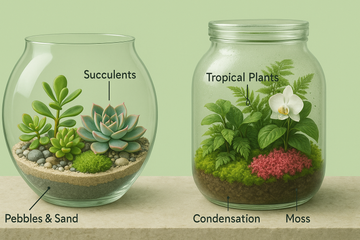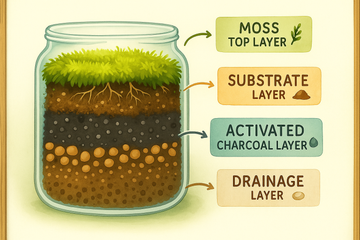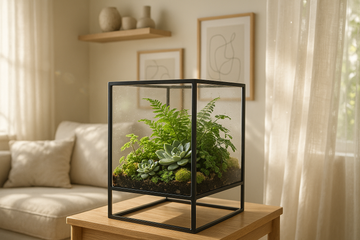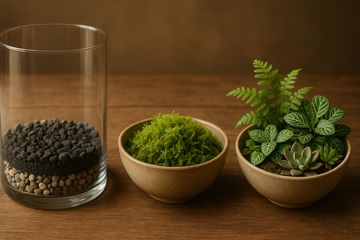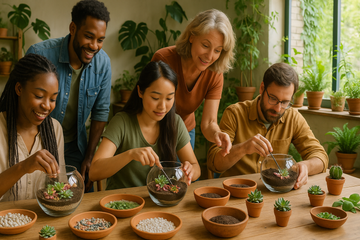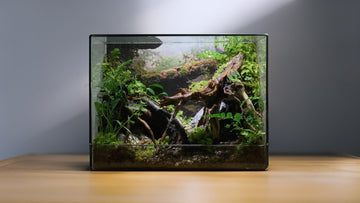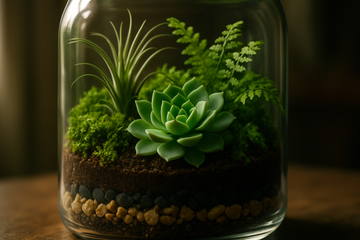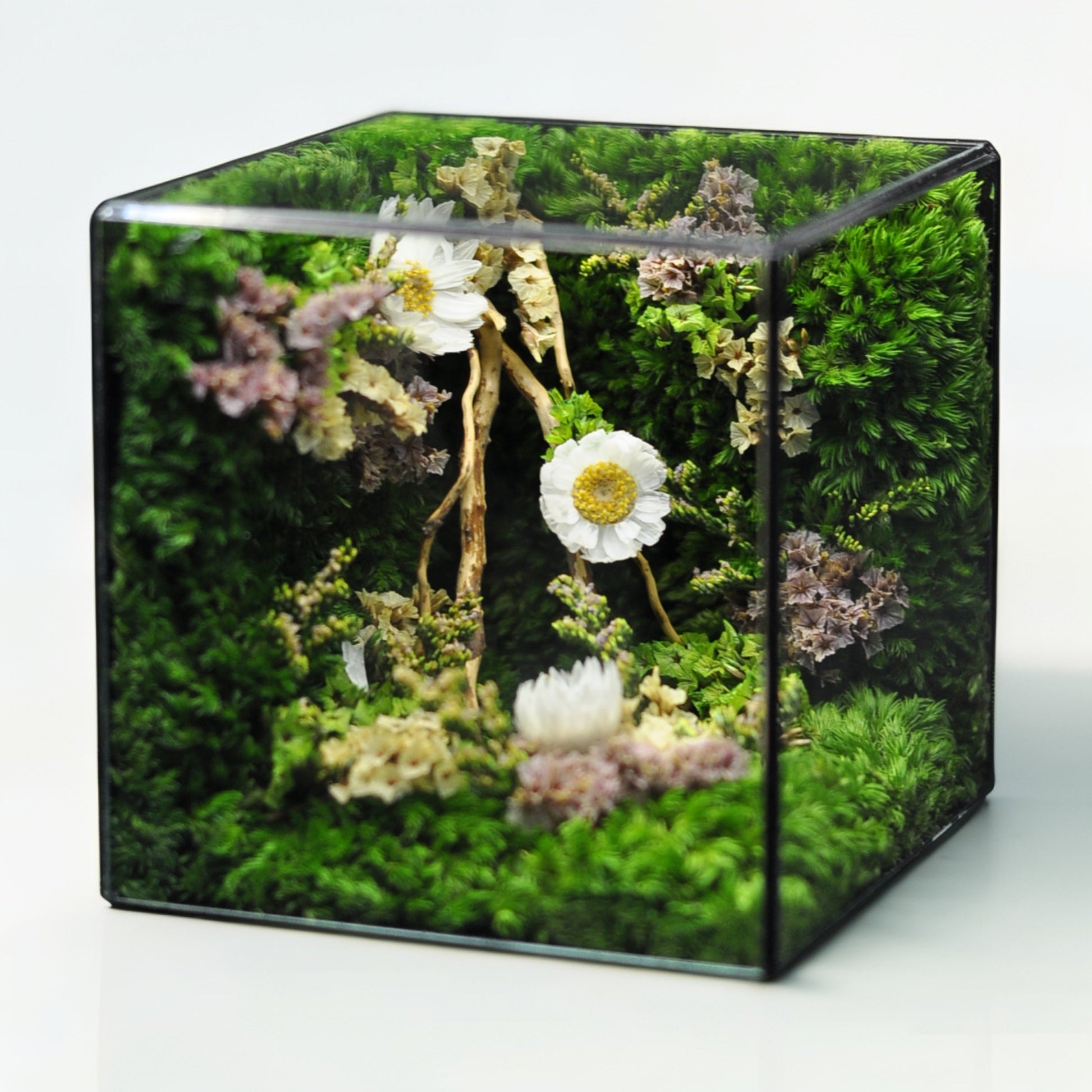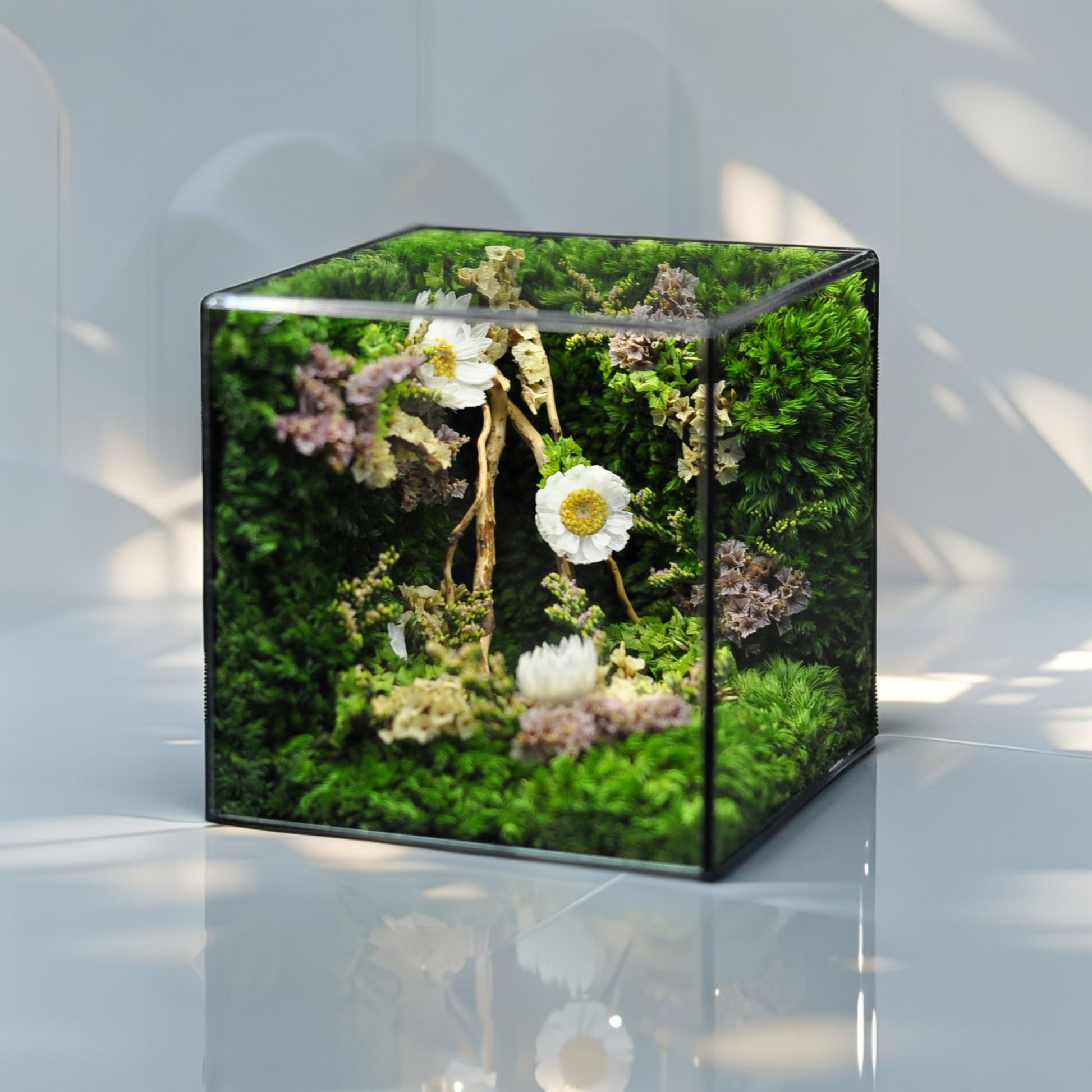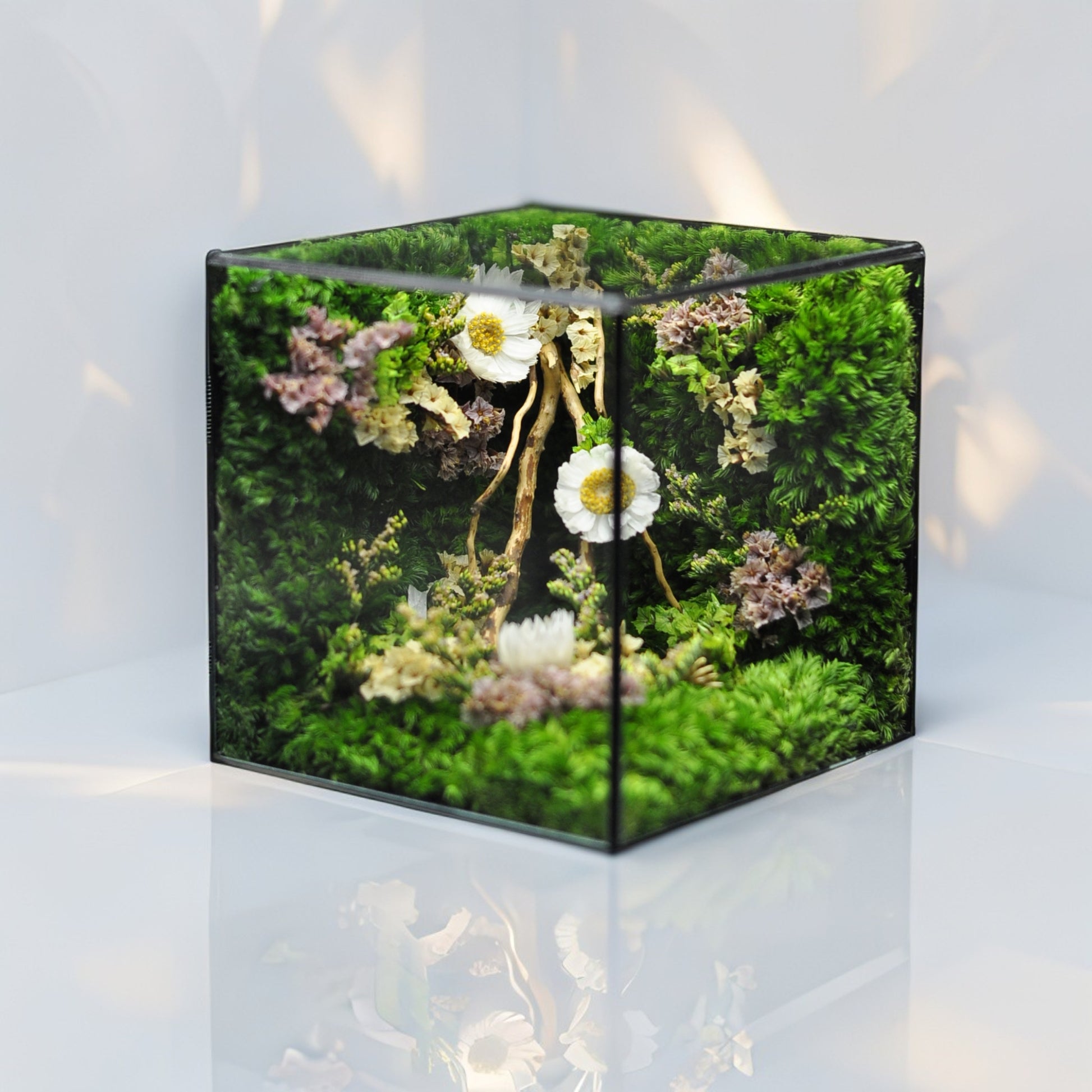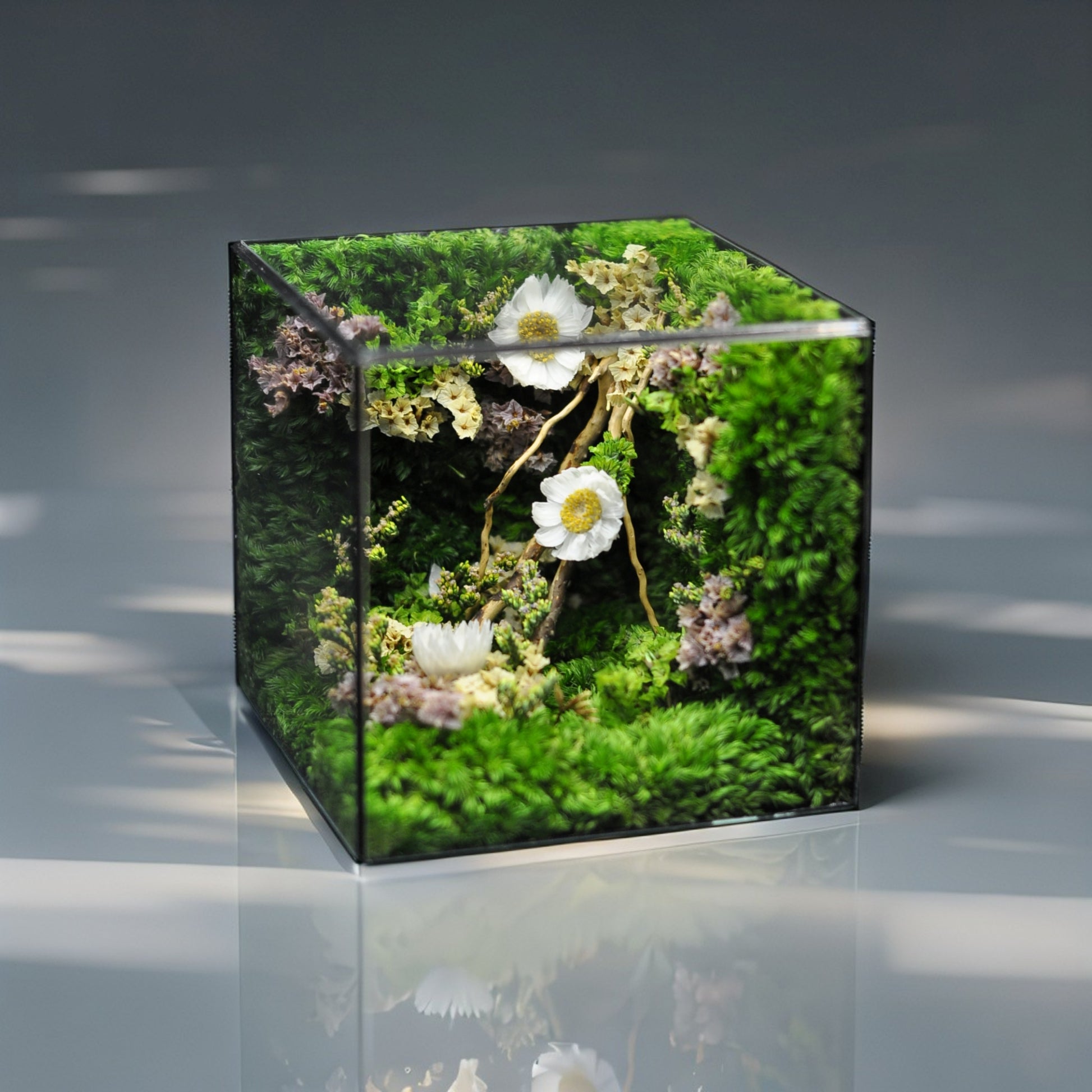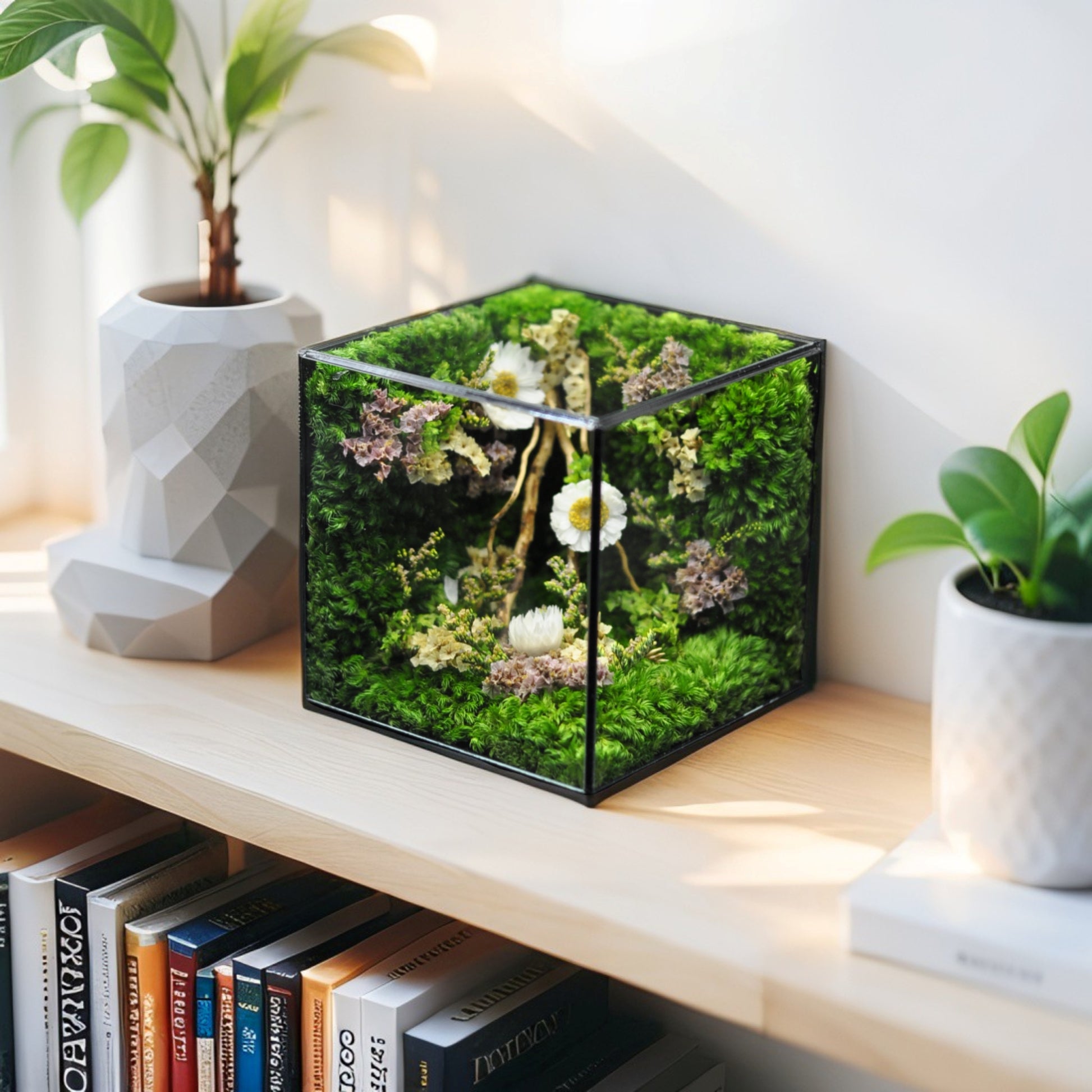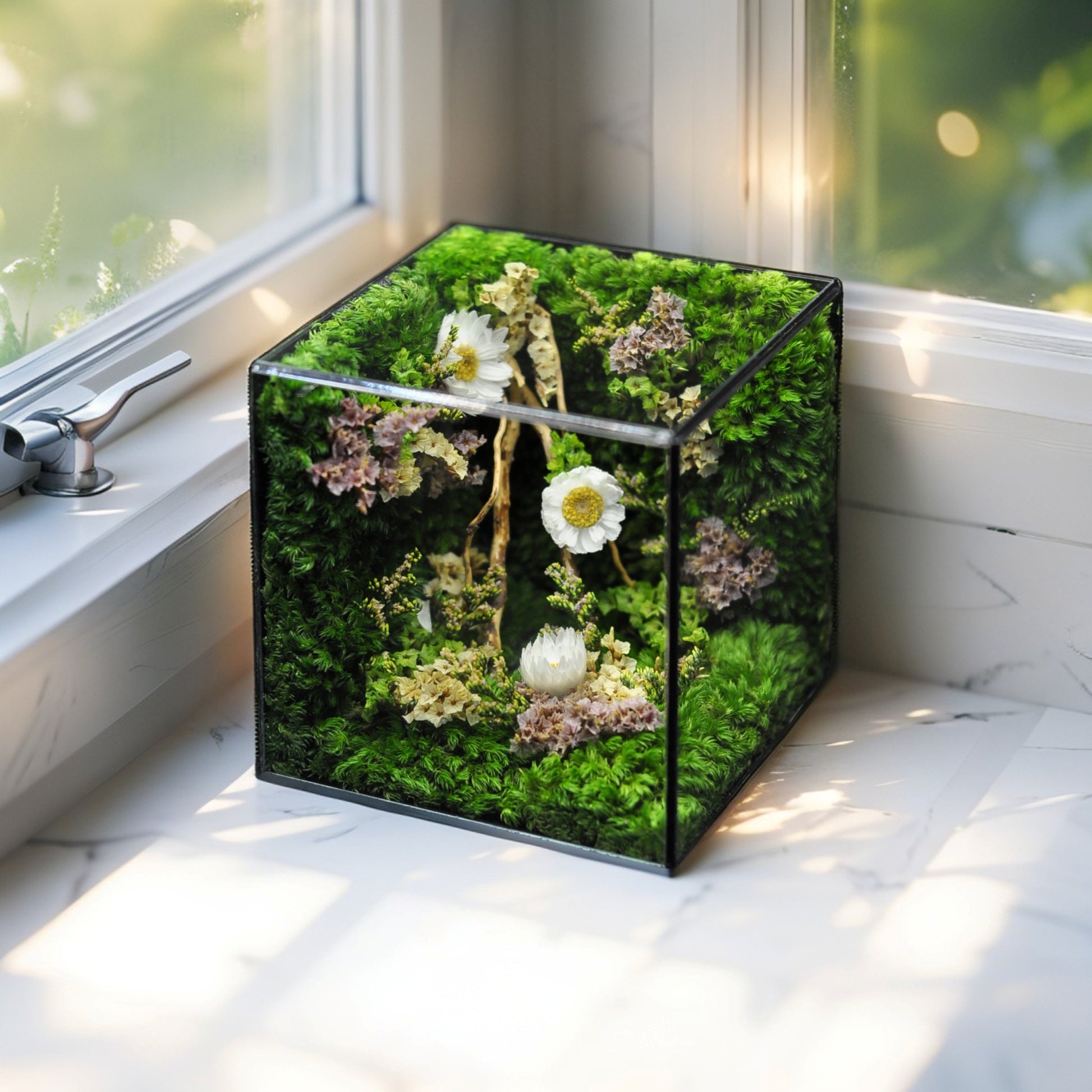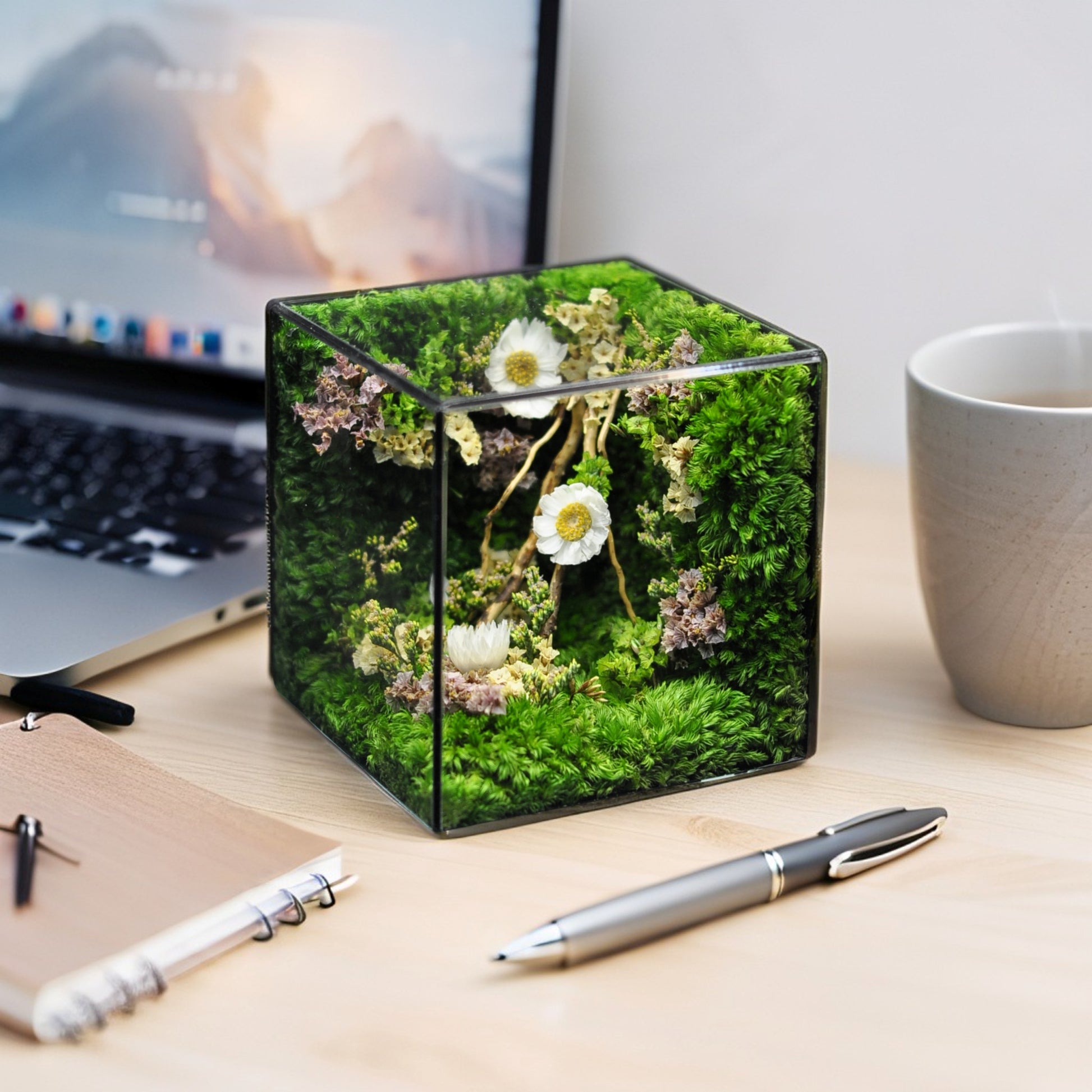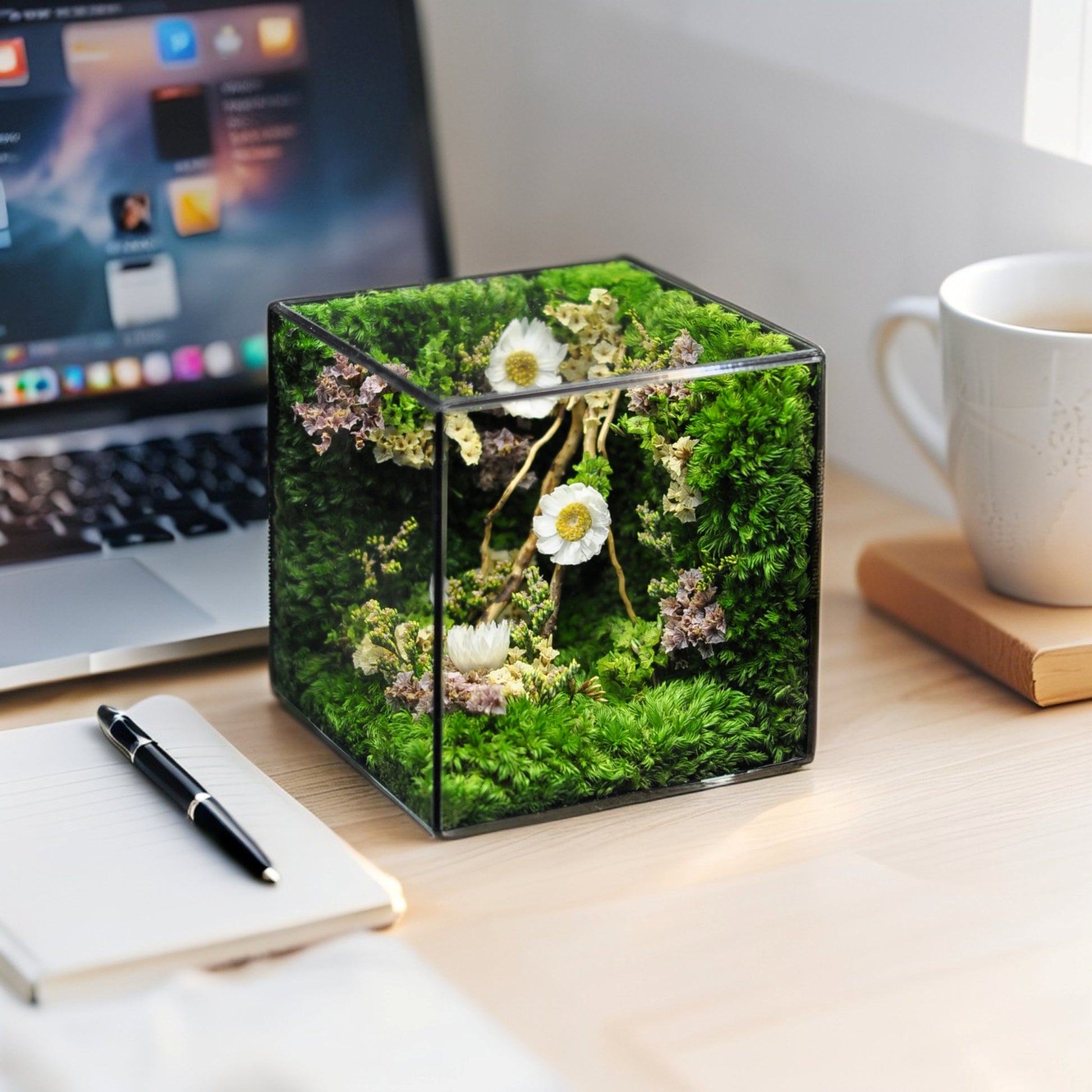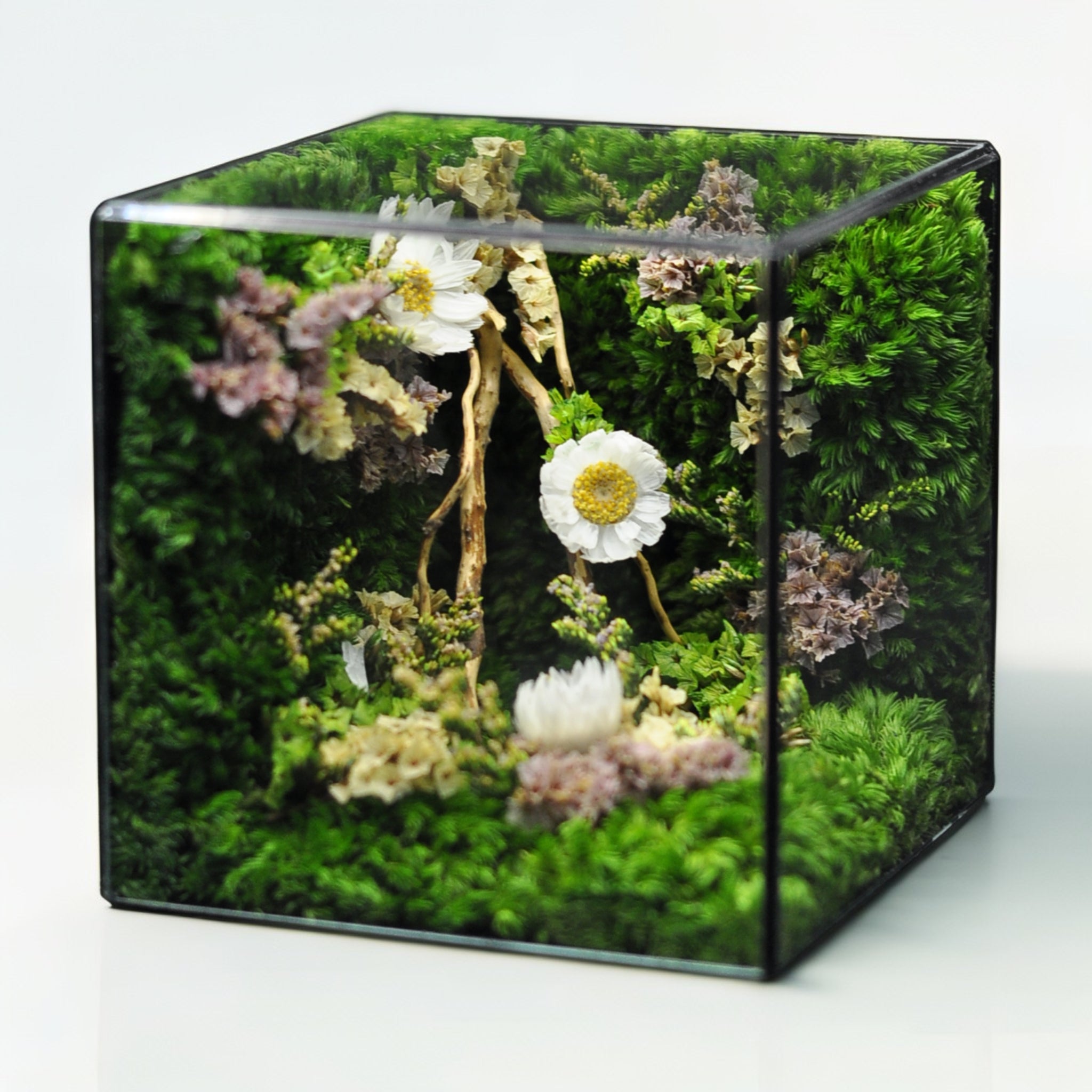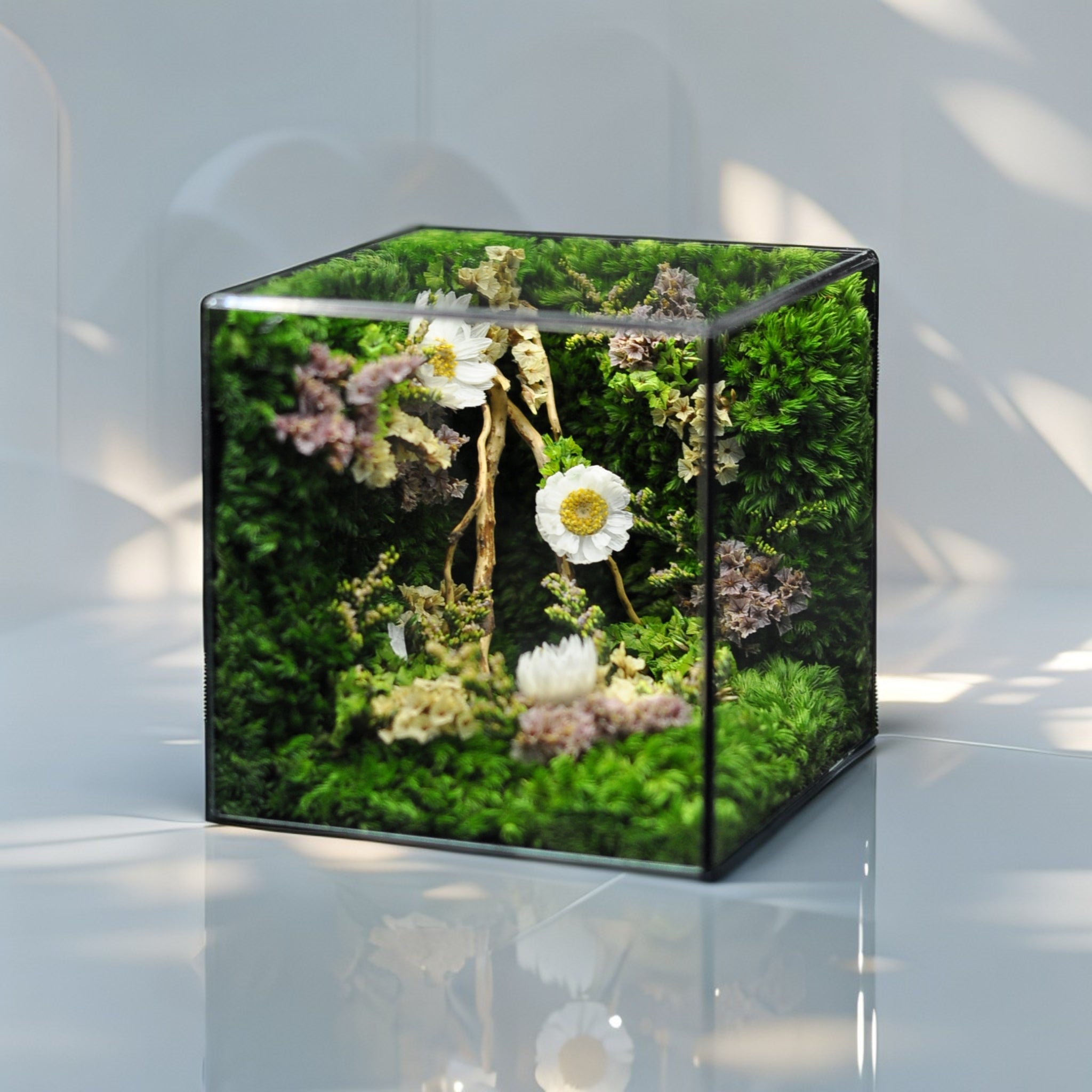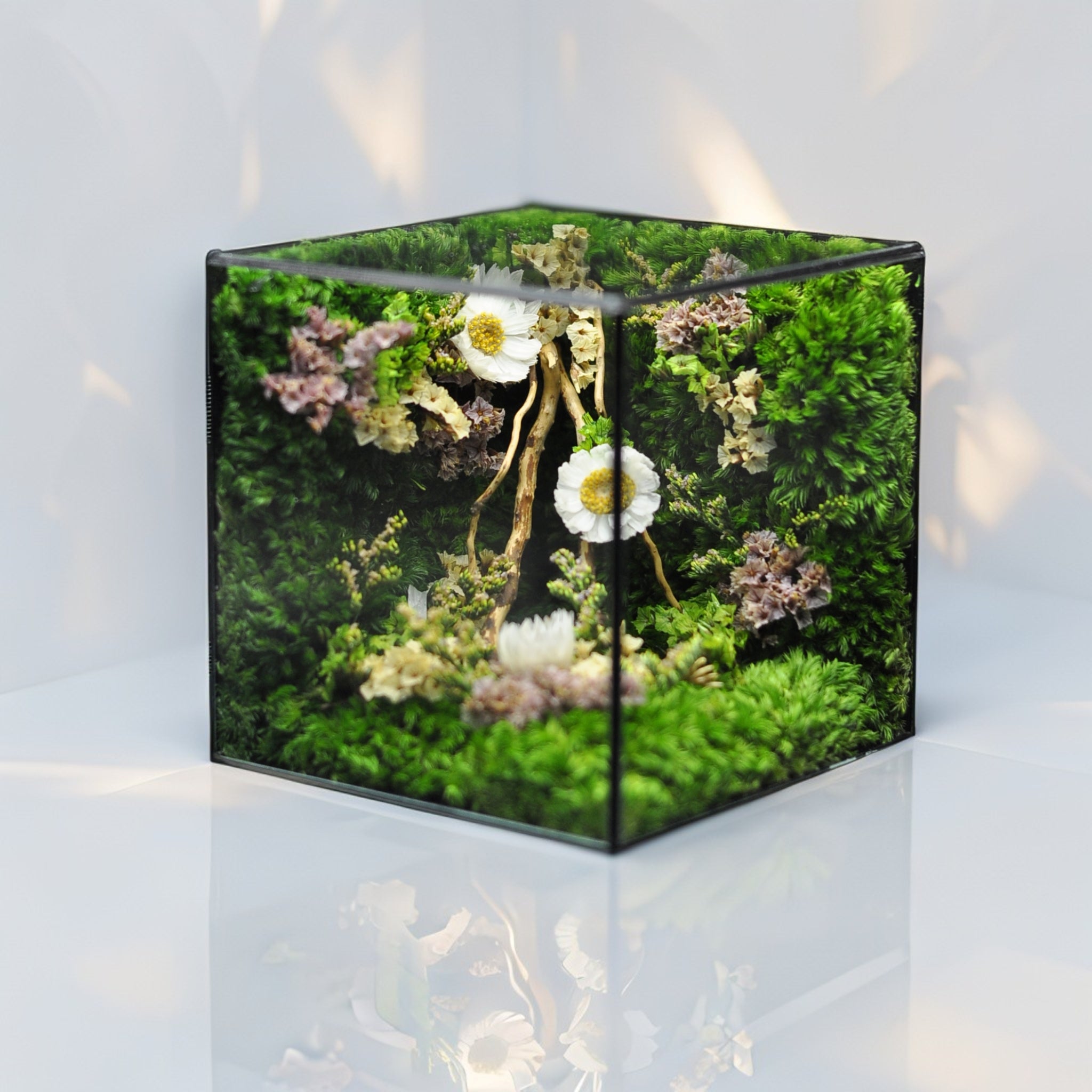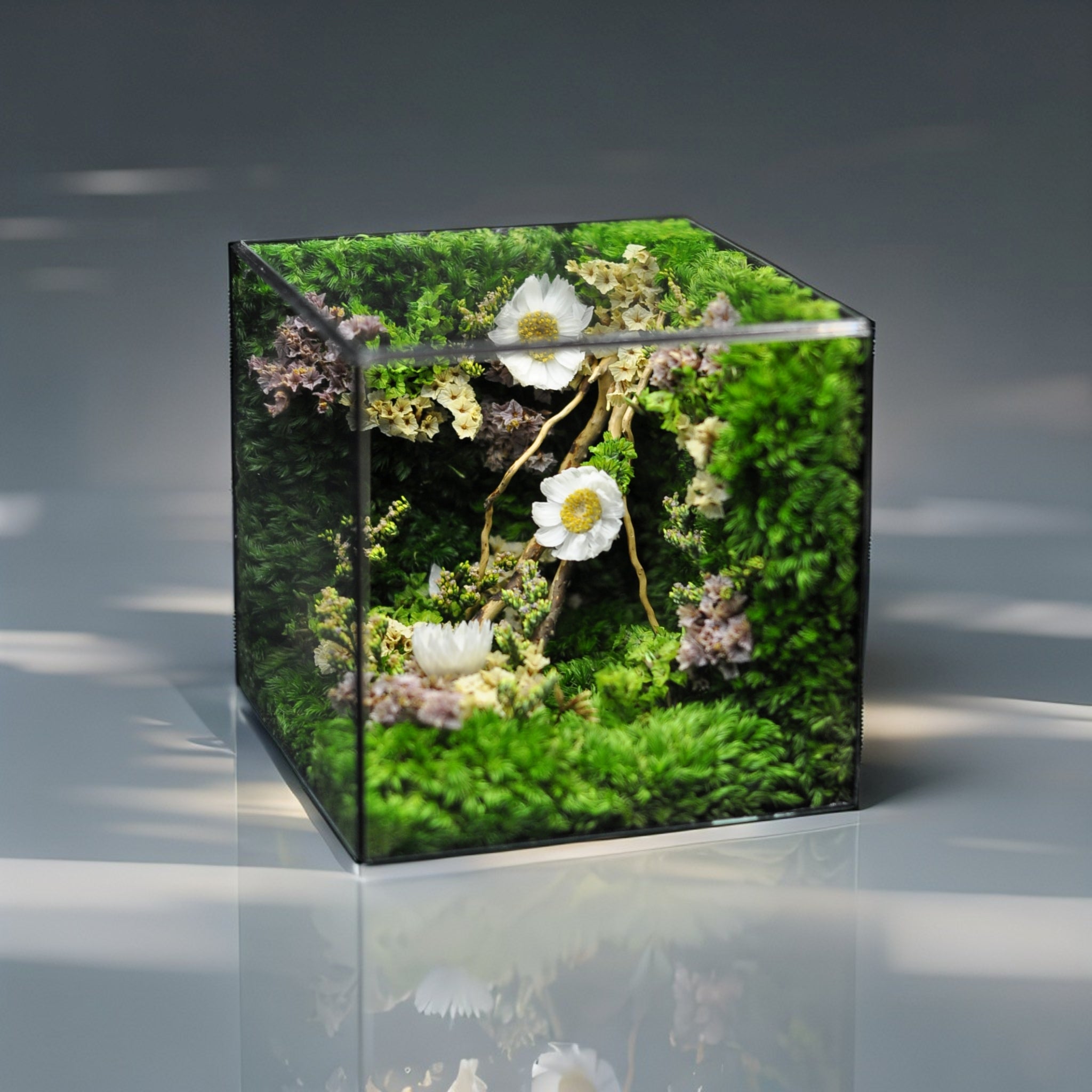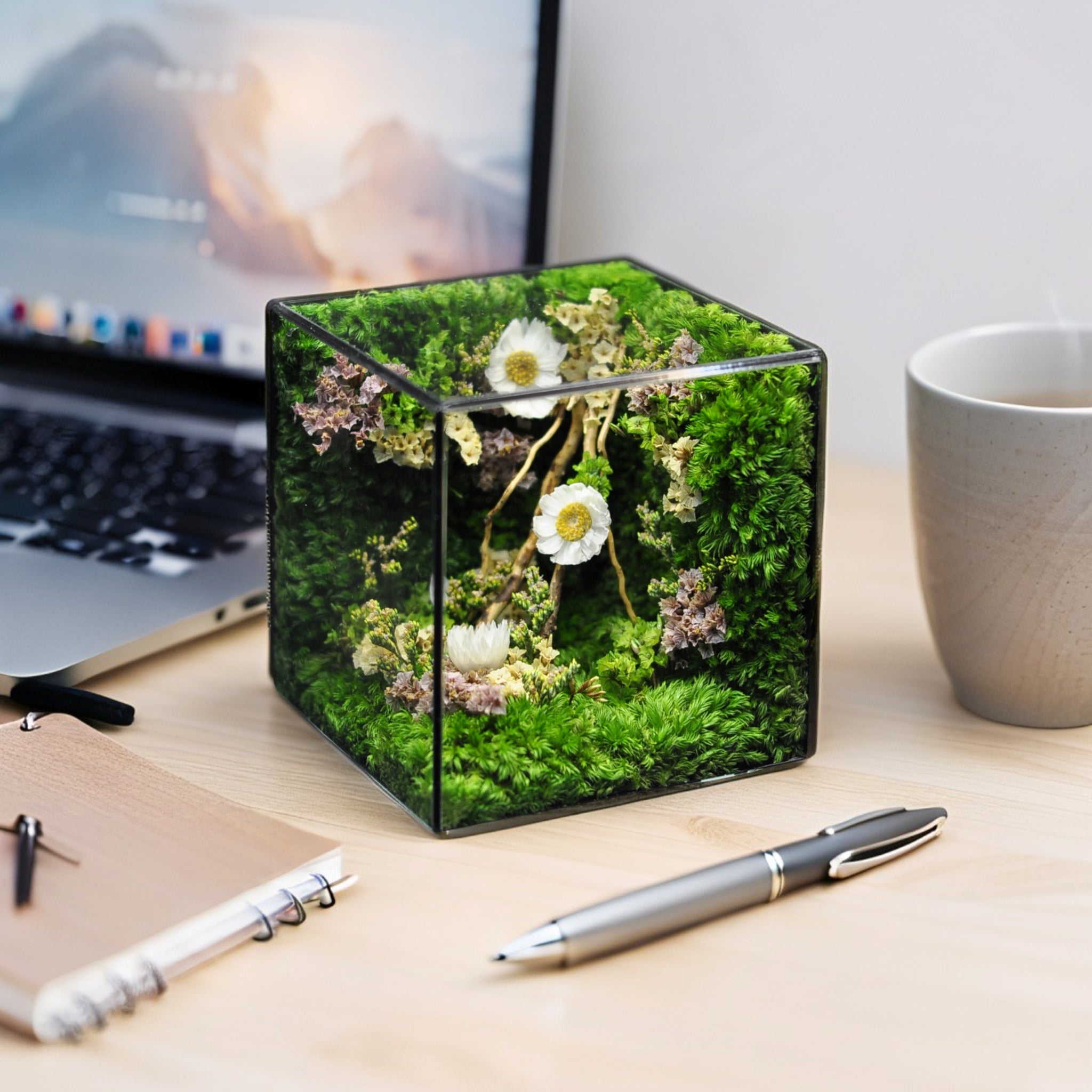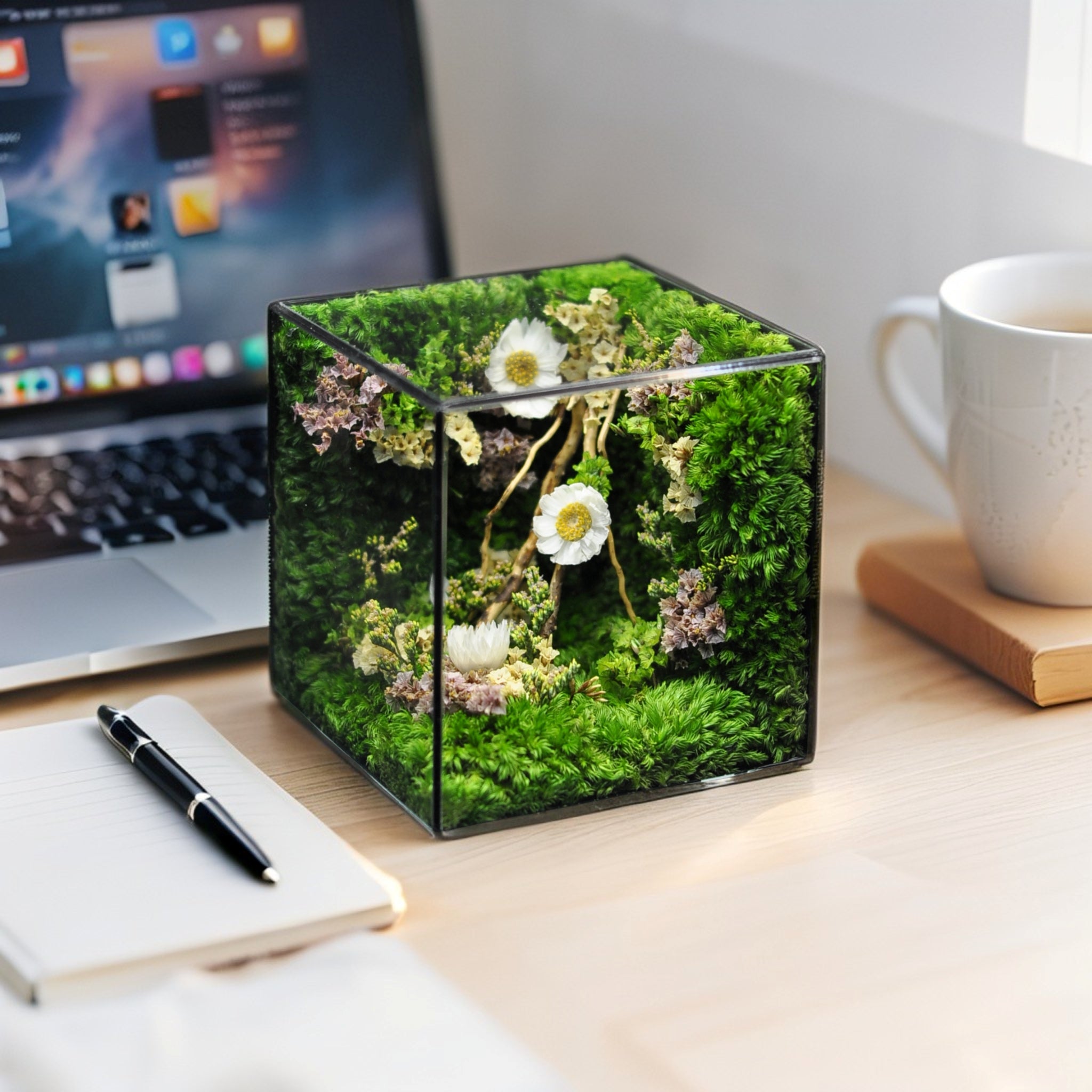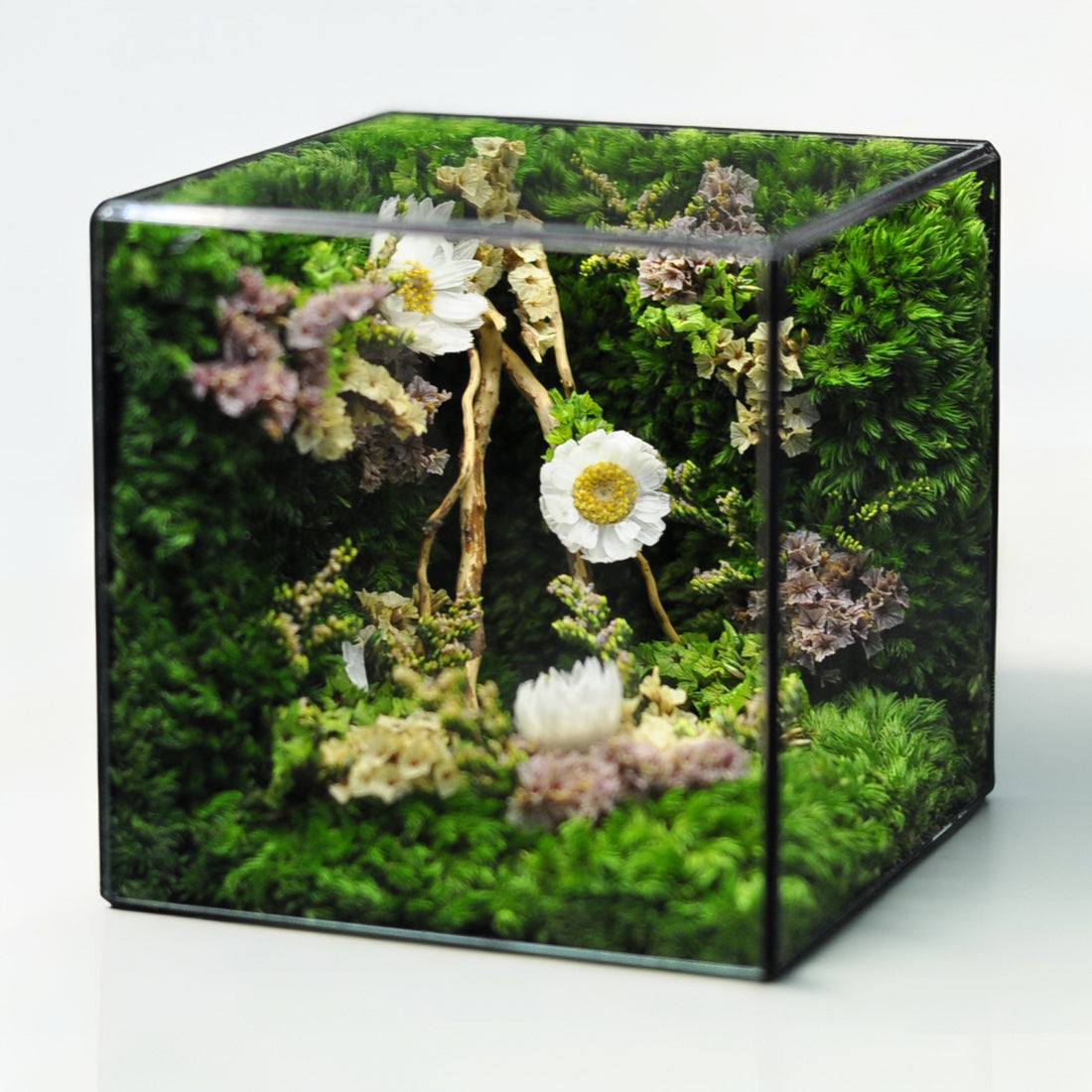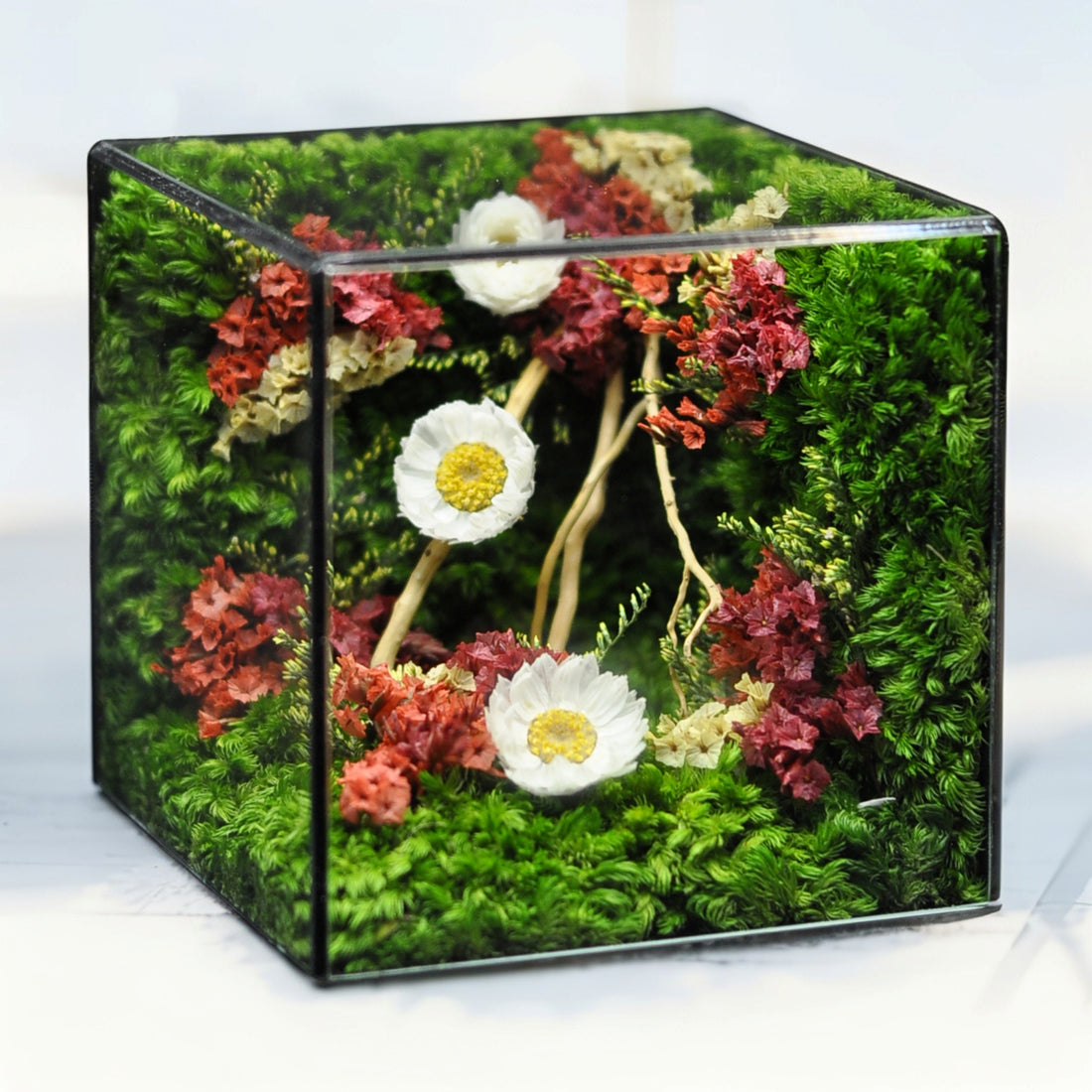Key Takeaways
Choosing between an open and closed terrarium involves assessing microclimates, plant needs, upkeep, and budget—all while envisioning how your new green display will elevate your space. The following takeaways distill the essential comparisons and buyer-centric guidance to help you select, style, and maintain the perfect terrarium setup.
- Compare humidity control with precision: Closed terrariums seal in moisture to create a self-regulating microclimate, while open terrariums demand regular watering and airflow to prevent mold and rot.
- Match your plants to the terrarium ecosystem: Tropical mosses, ferns, and orchids flourish in sealed environments, whereas succulents, air plants, and cacti prefer the drier, ventilated conditions of open containers.
- Balance maintenance demands and design goals: Open setups offer easy access for pruning and decor changes but require frequent monitoring; closed systems deliver low-touch care at the cost of limited reach and styling flexibility.
- Plan your budget with smart comparisons: DIY terrariums can start under $50 using thrifted glass vessels and standard substrates, while curated kits and premium glass containers range from $75 to $200—choose based on desired complexity and finish.
- Use a purchase-ready checklist for seamless setup: Gather a clear glass container, drainage materials (pebbles, charcoal), quality potting mix, selected plant varieties, and decorative elements before you begin to streamline assembly.
- Incorporate styling inspiration to elevate any room: Layer contrasting substrates, integrate miniature figurines or natural accents like driftwood, and select geometric or vintage glassware to ensure your terrarium complements your interior design.
With these insights in hand, you’re poised to dive deeper into each terrarium type’s construction steps, plant recommendations, care routines, and curated product picks—setting the stage for a thriving, beautiful indoor ecosystem.
Introduction
Imagine creating a lush indoor paradise, where vibrant plants flourish and bring life to your home, all encapsulated within a stunning glass container. The magic lies in understanding the nuances of terrarium setups—specifically the open versus closed terrarium debate. Each type offers a distinct aesthetic, plant compatibility, and maintenance demands that can significantly enhance your living space.
Choosing the right terrarium isn’t just about aesthetics; it directly impacts the health of your plants and your overall enjoyment of this green display. By dissecting essential factors such as humidity control, plant selection, upkeep, and cost, this article equips you with the knowledge to choose the perfect terrarium setup tailored to your environment and style. Get ready to explore how these microcosms can elevate your home's ambiance while ensuring a thriving natural ecosystem.
Did you know sealed terrariums can self-water for up to six months? Whether you prefer a low-touch ecosystem or the sculptural clarity of open designs, understanding open vs closed terrarium types is essential for indoor gardening success.
Overview of Open Terrariums vs Closed Terrariums
What is an open terrarium? (open terrarium vs closed terrarium)
An open terrarium features an unobstructed top that allows direct air exchange with its surroundings. Typically housed in shallow glass bowls, cloches, or wide-mouthed jars, this design maintains ambient humidity and requires active airflow—perfect for drought-tolerant species. The open style also offers easy access for planting, pruning, and decorative adjustments.
What is a closed terrarium?
A closed terrarium is a sealed glass environment that traps moisture to create a self-sustaining ecosystem. With tight-fitting lids or stoppers, it retains water vapor, generating a high-humidity microclimate. The system cycles water via evaporation and condensation with minimal external watering in typical indoor conditions, though very dry homes may require occasional top-ups. Common containers include tall cylinders, bell jars, and repurposed glass jars with airtight tops.
Key differences: humidity control, airflow, and aesthetics
- Humidity control
- Open: moderate, room-level moisture
- Closed: high humidity with visible condensation
- Airflow
- Open: unrestricted circulation reduces mold risk
- Closed: limited ventilation may require manual airing (GreenThumb Labs tests show venting every 2–4 weeks prevents mold buildup)
- Aesthetics
- Open: highlights plant structure and decorative substrate layers
- Closed: showcases lush, jungle-like scenes framed behind glass
For more on moisture management, see our Humidity Control Techniques guide.
How to choose between an open and closed terrarium (how to choose between an open and closed terrarium)
Selecting the right terrarium type depends on your environment, plant preferences, and maintenance style. Follow this decision pathway:
- Dry climate + minimal upkeep → Closed terrarium
- Bright, airy space + enjoy pruning → Open terrarium
- Moderate humidity + occasional misting → Semi-open design with a hinged lid
Also consider:
- Environment: High-humidity regions or dry indoor air favor closed systems; well-ventilated, moderate climates suit open setups.
- Plant profile: Succulents and cacti thrive in open terrariums; moisture-loving ferns and mosses excel in closed ones.
- Maintenance style: Open terrariums need regular watering and airflow; closed systems only require occasional venting and condensation checks.
Now that you know which terrarium type suits you, let’s select the right container and build your base layers.
Key Design & Construction Features
Selecting the right glass container terrarium (glass container terrarium)
Choosing an appropriate glass container ensures optimal light transmission, moisture retention, and visual harmony:
- Container shape: Cylinders and bell jars suit closed setups; shallow bowls and wide-mouthed aquariums work for open terrariums.
- Glass quality: Tempered or soda-lime glass resists temperature fluctuations and scratches—brands like IKEA’s Själland series offer budget-friendly options, while Umbra’s Trigg line delivers sleek geometric style.
- Size considerations: Larger volumes buffer humidity swings; compact vessels fit desks or shelves.
Explore our guide on glass container terrarium styles for more inspiration.
Terrarium substrate materials: drainage layers, charcoal, potting mix (terrarium substrate materials)
An effective substrate combines drainage, filtration, and nutrient-rich media:
- Drainage layer: 0.5–1 inch of pebbles or gravel prevents waterlogging.
- Activated charcoal: A thin layer filters toxins and reduces odors.
- Potting mix: For tropical plants, a 50:30:20 ratio of peat moss, perlite, and coconut coir offers balanced moisture and aeration; for succulents, use a sandier mix.
Learn more about ideal ratios in our soil mix ratios guide.
Layering and drainage essentials for humidity regulation
Proper layering creates a self-draining system that balances moisture:
- Clean the container thoroughly.
- Add a drainage layer of stones (0.5–1 inch).
- Spread a thin layer of activated charcoal.
- Place fine mesh or a coffee filter to separate soil from drainage.
- Top with 2–3 inches of potting mix and gently tamp.
- Create hollows for planting and decorative elements.
Purchase-ready checklist for seamless terrarium setup
Gather these items before assembly to streamline your build:
- Glass container terrarium (lid or open top)
- Pebbles or gravel for drainage
- Activated charcoal
- Quality potting mix or orchid medium
- Fine mesh or filter fabric
- Selected plants (see compatibility section)
- Terrarium tools: long tweezers, miniature spade, spray bottle
- Decorative accents: moss, stones, figurines
- Lighting: LED grow lamp or spot near natural light source
With your materials in hand, you’re ready to choose plants that thrive in your chosen terrarium type.
Plant Compatibility for Different Terrarium Types
Best plants for closed terrariums: tropical mosses, ferns, orchids (best plants for closed terrariums)
Closed terrariums suit high-humidity, low-light microclimates:
- Tropical mosses: sheet moss (Hypnum), Java moss (Vesicularia dubyana)
- Ferns: maidenhair (Adiantum), button fern (Pellaea rotundifolia)
- Orchids: Phalaenopsis, mini Dendrobium species
- Accents: Pilea peperomioides, Fittonia
Best plants for open terrariums: succulents, air plants, cacti
Open terrariums support drought-tolerant species:
- Succulents: Echeveria, Haworthia, Crassula
- Air plants: Tillandsia ionantha, Tillandsia xerographica
- Cacti: small Mammillaria species
- Accents: Sedum, miniature echeverias
Explore tips in our succulent and cactus care resources.
Matching plant needs to terrarium humidity control (terrarium humidity control)
Align plant selection with terrarium humidity to prevent stress:
- Open: ideal for dry, airy conditions.
- Closed: suited for ferns, mosses, and tropical foliage needing constant moisture.
- Transitional setups: partial covers or hinged lids allow mixed plant introductions.
Maintenance Requirements and Care
Closed terrarium care: low-touch humidity regulation (closed terrarium care)
Closed terrariums rely on passive water cycling:
- Monitor condensation: excessive droplets signal over-saturation.
- Vent every 2–4 weeks to refresh air and manage humidity (GreenThumb Labs).
- Inspect for mold: remove decaying material promptly.
- Trim growth: prune leggy shoots to maintain balance.
Pro Tip: Set a calendar reminder for monthly checks.
User Story: After switching to a closed terrarium, hobbyist Anna in Seattle cut her watering from weekly to monthly.
Open terrarium care: watering schedules and airflow to prevent mold (How often should I water my terrarium?)
Watering frequency depends on plant type and environment:
- Succulents: water every 7–14 days (Royal Horticultural Society).
- Air plants: mist 1–2 times per week.
Watch for:
- Under-watering: shriveled leaves or dry substrate.
- Over-watering: soggy soil or standing water.
- Airflow: position near a fan or open window to reduce stagnant moisture.
For detailed ventilation tips, see Airflow Best Practices.
Addressing common challenges in terrarium upkeep
Mini Troubleshooting Decision Tree:
- Mold appears? Increase ventilation, remove affected spots, adjust watering.
- Plants become leggy? Enhance light or prune elongated stems.
- Yellowing leaves? Check moisture levels and trim dead material.
- Nutrient depletion? Apply diluted liquid fertilizer every 3–4 months.
- Pests? Isolate the terrarium and treat with insecticidal soap.
FAQ: Can I mix succulents and moss in a half-closed terrarium?
Yes—use a partially open lid to balance humidity and airflow, and choose drought-tolerant moss varieties.
Is a closed terrarium low maintenance?
Closed terrariums generally require less frequent watering and trimming than open setups. For hobbyists seeking a “set-and-forget” display, sealed ecosystems offer the lowest ongoing effort.
Cost Comparison and Budgeting
DIY vs curated kits: budget terrarium kits for beginners (budget terrarium kits for beginners)
DIY setups cost $20–$50, entry-level kits run $40–$80, and premium kits range $100–$150.
Mini Case Study: Our $50 DIY kit yielded healthy growth but required close moisture monitoring. The $75 beginner kit delivered more consistent humidity control and reduced mold risk, making it ideal for new hobbyists.
We recommend kits priced $50–$80 to balance quality and affordability.
Cost breakdown: under $50 DIY to $200 premium setups
- Under $50: recycled jars, basic substrate, common succulents/mosses
- $50–$100: mid-tier glass terrariums, diverse plant selection
- $100–$200: designer containers, specialty plants, decorative accents
Long-term expenses: substrate replenishment and plant replacements
- Substrate refresh every 1–2 years: $10–$20
- Plant replacements: $5–$15 per specimen
- Decorative accent refresh: $5–$25
Styling Inspiration to Elevate Your Space
Layering contrasting substrates and decorative accents
Create visual interest with substrate contrasts:
- Black sand over white pebbles for modern flair
- Bands of coco coir and colored sand for landscape stripes
- Moss carpets with bright gravel pathways
Integrating miniature figurines, driftwood, and natural elements
Scale-appropriate accents enhance themes:
- Mini animal or fairy figurines among foliage
- Driftwood branches for vertical lines
- Shells or tiny pinecones for coastal or forest scenes
Insider Trick: Avoid overcrowding; leave space for plant growth.
Choosing geometric or vintage glassware for design impact
Container shape influences style:
- Geometric house shapes (hexagons, pentagons) for contemporary settings
- Vintage apothecary jars for an antique vibe
- Tall cylinders for cascading plants
See our geometric terrarium style inspirations for more ideas.
Making the Final Decision: Terrarium Types Comparison
Quick reference chart: open vs closed terrarium at a glance (terrarium types comparison)
| Attribute | Open Terrarium | Closed Terrarium ||---------------------|---------------------------------------------|---------------------------------------------|| Humidity Control | Moderate, room-level moisture | High, self-regulating moisture || Airflow | Unrestricted, reduces mold risk | Limited, may require manual airing || Maintenance | Moderate—regular watering and pruning | Low—occasional venting and moisture checks || Ideal Plants | Succulents, cacti, air plants | Tropical mosses, ferns, orchids || Visual Style | Clean, structured layers | Lush, enclosed ecosystem |
How to choose between an open and closed terrarium for your home (how to choose between an open and closed terrarium)
To decide how to choose between an open and closed terrarium for your home, weigh three factors:
- Ambient environment: High-humidity homes suit closed terrariums; arid or drafty spaces favor open designs.
- Time commitment: Closed terrariums require minimal watering; open setups demand frequent checks.
- Aesthetic preference: Choose open terrariums for architectural clarity; sealed models for rainforest-like scenes.
Expert tips for terrarium success
- Place terrariums in bright, indirect light to avoid scorching or algae growth.
- Use distilled or rainwater for closed terrariums to reduce mineral buildup.
- Start with slow-growing plants to maintain proportion and reduce pruning.
- Wipe glass interiors gently with a soft cloth to keep visibility high.
- Rotate the container periodically for even light exposure and growth.
Conclusion
Choosing between open and closed terrariums is essential for crafting a flourishing indoor garden that complements your lifestyle and environment. Open terrariums provide flexibility and accessibility, perfect for drought-resistant plants like succulents and cacti. In contrast, closed terrariums create self-sustaining ecosystems ideal for humidity-loving species such as ferns and tropical mosses. This distinction revolves around key factors like humidity control, airflow, and maintenance needs, as we explored throughout the guide.
Understanding these dynamics equips you to make informed decisions about your terrarium setup, ensuring not only aesthetic appeal but also the health and longevity of your plants. As you embark on your terrarium journey, consider experimenting with different designs and plant combinations to see what thrives best in your space. In doing so, you can cultivate a green oasis that enhances your home while providing a rewarding gardening experience—one that evolves alongside your interests and knowledge.
Frequently Asked Questions (FAQ)
Q: What’s the difference between an open and a closed terrarium?
A: Open terrariums have an unobstructed top for direct air exchange and maintain moderate, room-level humidity, making them ideal for drought-tolerant plants and easy access. Closed terrariums are sealed glass environments that trap moisture to create a high-humidity, self-sustaining microclimate, cycling water via evaporation and condensation with minimal external watering.
Q: Which plants thrive in a closed terrarium?
A: Closed terrariums suit moisture-loving species such as tropical mosses (sheet moss, Java moss), ferns (maidenhair, button fern), orchids (Phalaenopsis, mini Dendrobium), and accents like Pilea peperomioides and Fittonia.
Q: How often should I water my terrarium?
A: Succulents in open terrariums need watering every 7–14 days, and air plants should be misted 1–2 times per week. Closed terrariums self-water for up to six months and only need an occasional top-up in very dry homes.
Q: Is a closed terrarium low maintenance?
A: Yes. Closed terrariums generally require less frequent watering and trimming than open setups. They rely on passive water cycling and typically need only occasional venting every 2–4 weeks, monthly condensation checks, and minimal pruning.
Q: How much does it cost to set up a terrarium?
A: Basic DIY builds cost around $20–$50. Entry-level kits run $40–$80, premium kits range $100–$150, and high-end setups can reach up to $200 depending on container style, plant selection, and decorative accents.
Q: How do I select the right glass container for my terrarium?
A: Choose container shape by terrarium type—cylinders and bell jars suit closed systems, while shallow bowls and wide-mouthed aquariums work for open designs. Opt for tempered or soda-lime glass for durability, and size the vessel to buffer humidity swings or fit your available space.
Q: What substrate layers are essential for a successful terrarium?
A: A proper terrarium substrate includes 0.5–1 inch of pebbles or gravel for drainage, a thin layer of activated charcoal for toxin filtration, a separation layer of fine mesh or coffee filter, and 2–3 inches of potting mix (peat moss, perlite, coconut coir for tropical setups; a sandier mix for succulents).
Q: How do I choose between an open and a closed terrarium for my home?
A: Follow this decision pathway: if your indoor air is dry and you want minimal upkeep, choose a closed terrarium; if you have a bright, airy space and enjoy regular pruning, opt for an open design; for moderate humidity with occasional misting, consider a semi-open model with a hinged lid.

